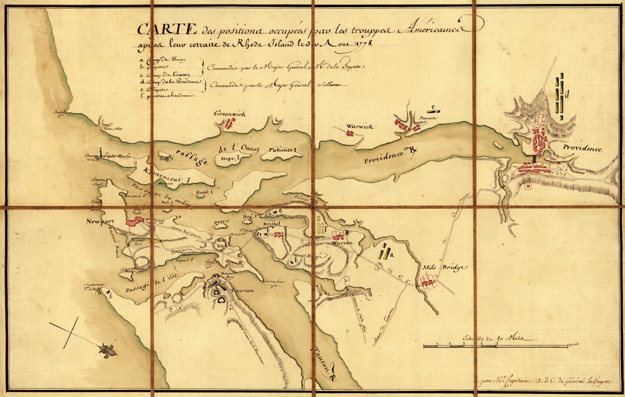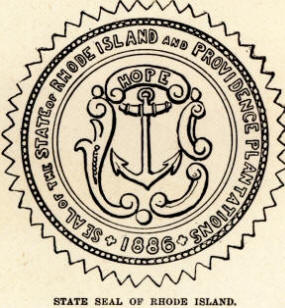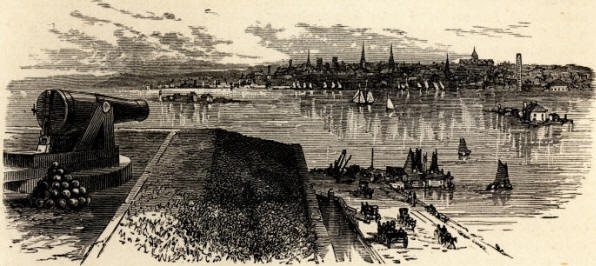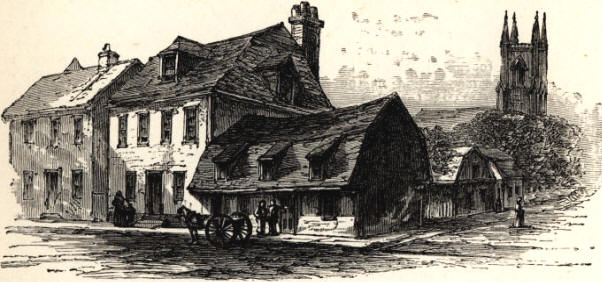Rhode Island
|
|
This Site:
|
Map of Rhode Island from Revolutionary War Era
The spot where Williams began a settlement he called Providence, in acknowledgment of the goodness of God towards him. The government he there established was a pure democracy, and in accordance with his tolerant views of the rights of conscience. Every settler then and afterwards was required to sign an agreement to give active or passive obedience to all ordinances that should be made by a majority of the inhabitants—heads of families—or the. public good. For some time the government was administered by means of town meetings. In 1638 William Coddington and others, driven from Massachusetts by persecution, bought of the Indians the island of Aquiday or Aquitneck, and made settlements on the site of Newport and Portsmouth. A third settlement was formed at Warwick, on the mainland, in 1643, by a party of whom John Greene and Samuel Gorton were leaders. The same year Williams went to England, and in 1644 brought back a charter which united the settlements at Providence and on Rhode Island under one government, called the Rhode Island and Providence Plantations. Commonwealth is EstablishedThen the commonwealth of Rhode Island was established, though the new government did not go into operation until 1647, when the first General Assembly, composed of the collective freemen of the several plantations, met at Portsmouth (May 19) and established a code of laws for carrying on civil government. The charter was confirmed by Cromwell (1655), and a new one was obtained from Charles II. (1663), under which the commonwealth of Rhode Island was governed 180 years. In the war with King Philip (1676) the inhabitants of Rhode Island suffered fearfully. Towns and farmhouses were burned and the people murdered. Providence was laid in ashes. The decisive battle that ended the war was fought on Rhode Island soil. When Sir Edmund Andros, governor of New England, was instructed to take away the colonial charters (1687), he seized that of Rhode Island, but it was returned on the accession of William and Mary (1689), and the people readopted the seal --an anchor for a device and " Hope" for a motto.
House in Old NewportRhode Island was excluded from the New England Confederacy (1643-1686), but it always bore a share of the burden of defending the New England provinces. Its history is identified with that of New England in general from the commencement of King William's War, for that colony took an active part in the struggle between Great Britain and France for empire in America, furnishing troops and seamen. The colony had fifty privateer vessels at sea in 1756, manned 1,500 seamen, which cruised along the American shores and among the West India Islands. The people of Rhode Island were conspicuous for their patriotism in the stirring events preliminary to the breaking out of the Revolutionary War, and were very active during that war. The first commander-in-chief of the Continental navy was a native of Rhode Island, Esek Hopkins, and the first naval squadron sent against the enemy at the beginning of the Revolution sailed from Providence. When the various colonies were forming new State constitutions (1776-79), Rhode Island went forward in its independent course under its old charter from Charles II.; and it was the last of the thirteen States to ratify the national Constitution, its assent not being given until May 29, 1790, or more than a year after the national government went into operation. Under the charter of Charles II. the lower House of the legislature consisted of six deputies from Newport, four each from Providence, Portsmouth, and Warwick, and two from each of the other towns. The right of suffrage was restricted to owners of a freehold worth $134, or renting for $7 a year, and to their eldest sons. These restrictions, as they became more and more obnoxious, finally produced open discontent. The inequality of representation was the chief cause of complaint. It appeared that in 1840, when Newport had only 8,333 inhabitants, it was entitled to six representatives; while Providence, then containing 23,171 inhabitants, had only four representatives. Attempts to obtain reform by the action of the legislature having failed, " suffrage associations " were formed in various parts of the State late in 1840 and early in 1841. They assembled in mass convention at Providence July 5, 1841. and authorized their State committee to call a convention to prepare a constitution. That convention assembled at Providence October 4, and framed a constitution which was submitted to the people December 27, 28, and 29, when it was claimed that a vote equal to a majority of the adult male citizens of the State was given for its adoption. The new government attempted to organize at Providence on May 3. They were resisted by what was called the " legal State government," chosen under the charter, at the head of which was Governor Samuel W. King. On the 18th a portion of the " Suffrage party " assembled under arms at Providence and attempted to seize the arsenal, but retired on the approach of Governor King with a military force. On June 25 they reassambled, several hundred strong, at Chepacket, 10 miles from Providence, but they again dispersed on the approach of State troops. Governor Dorr was arrested, tried for high-treason, convicted, and sentenced to imprisonment for life, but was released in 1847, under a general act of amnesty. See DORR, THOMAS WILSON. Meanwhile the legislature (Feb. 6, 1841) called a convention to frame a new constitution. In February, 1842, the convention agreed upon a constitution, which was submitted to the people in March and rejected. Another constitution was framed by another convention, which was ratified by the people almost unanimously, and went into effect in May, 1843. In 1861 a controversy between Rhode Island and Massachusetts about boundary, which began in colonial times, was settled by mutual concessions, the former ceding to the latter that portion of the township of Tiverton containing the village of Fall River in exchange for the town of Pawtucket and a part of Seekonk, afterwards known as East Providence. Rhode Island was among the earliest to respond to President Lincoln's first call for troops, and during the Civil War, the State, with a population of only 175,000, furnished to the National army 23,711 soldiers. Population in 1890, 345,506 ; 1900, 428,556.
|
|
|
||
|
|
Site Copyright 2003-2018 Son of the South. For Questions or comments about this collection, contact: paul@sonofthesouth.net |
|
|
Are you Scared and Confused? Read My Snake Story, a story of hope and encouragement, to help you face your fears. |
||

 Rhode
Island, STATE OF, was one of the
Rhode
Island, STATE OF, was one of the

